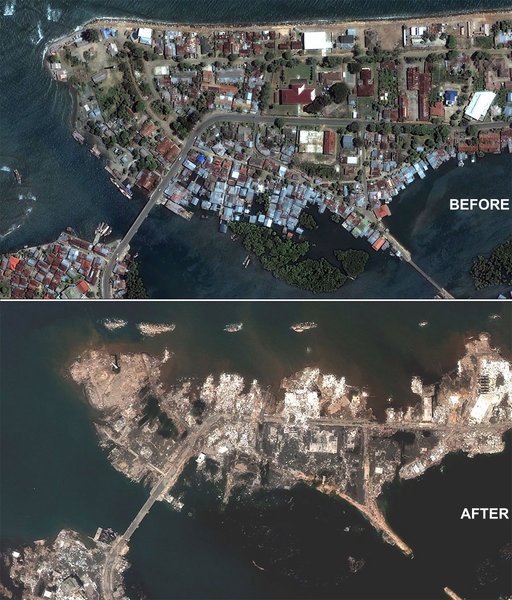2004 Indian Ocean Earthquake and Tsunami
On 26 December 2004, a Tsunami struck the West Coast of Sumatra, Indonesia. This was by far the hardest place to be hit, with the most casualties anywhere, although there were unfortunately many other places to be hit by tsunamis after the 9.3 earthquake causing so much destruction.Destruction by enormous waves was felt as far as Hawaii, where 166,000 people were killed, lost, or drowned. There was also $4.75 billion in damages to the Hawaiian Islands. The third largest earthquake ever recorded, 19 miles beneath the seabed there was 60 miles wide by 250 miles long subduction according to seismograph detections that also recorded a hypocenter (focus) that was 100 mi long beginning at the Northern end of the Sumatran Island of Simeulue island. The start of this earthquake then caused an aftershock that amounted to 810 miles in length causing a second wave of tsunamis and shedding the lives of thousands of people all over the Asian Continent, especially in Indonesia. This is where 130,736 confirmed deaths were accounted for and over 500,000 displaced. other countries devastated by the tsunamis that struck mainly the coastlines were India, Hawaii, Indonesia, and other small Pacific and Indian Ocean islands. The top of the Earths crust was shifted as much as 19 feet at the bottom of the Indian Ocean where specified earlier.  The death and destruction that came with an earthquake that could be triggered at any time could possibly be mitigated by using the energy the wave creates to power small generators turning propellers going the opposite direction of the wave. In turn slowing down the wave enough to be much smaller and less deadly. These generators would be submerged at specific intervals and locations along the entire fault line. The generators would have small gps tracking, and computer access from satellites and could be turned on automatically from seismic vibrations allowing a system to be assembled that formed a mesh or wire band along the entire area that was set on by underwater movement and vibration. After assembling the net or cable, the small computers would not be a way to disassemble it until recovered. The net would need to be a material that was very strong and would slow down water as it moves toward shore
The death and destruction that came with an earthquake that could be triggered at any time could possibly be mitigated by using the energy the wave creates to power small generators turning propellers going the opposite direction of the wave. In turn slowing down the wave enough to be much smaller and less deadly. These generators would be submerged at specific intervals and locations along the entire fault line. The generators would have small gps tracking, and computer access from satellites and could be turned on automatically from seismic vibrations allowing a system to be assembled that formed a mesh or wire band along the entire area that was set on by underwater movement and vibration. After assembling the net or cable, the small computers would not be a way to disassemble it until recovered. The net would need to be a material that was very strong and would slow down water as it moves toward shore
Sources: http://en.wikipedia.org/wiki/2004_Indian_Ocean_earthquake_and_tsunami https://support.rms.com/publications/IndianOceanTsunamiReport.pdfhttp://www.pbs.org/wnet/nature/episodes/violent-hawaii/deadly-tsunamis/1862/http://www.youtube.com/watch?v=Q5x6a5kAke0
 The death and destruction that came with an earthquake that could be triggered at any time could possibly be mitigated by using the energy the wave creates to power small generators turning propellers going the opposite direction of the wave. In turn slowing down the wave enough to be much smaller and less deadly. These generators would be submerged at specific intervals and locations along the entire fault line. The generators would have small gps tracking, and computer access from satellites and could be turned on automatically from seismic vibrations allowing a system to be assembled that formed a mesh or wire band along the entire area that was set on by underwater movement and vibration. After assembling the net or cable, the small computers would not be a way to disassemble it until recovered. The net would need to be a material that was very strong and would slow down water as it moves toward shore
The death and destruction that came with an earthquake that could be triggered at any time could possibly be mitigated by using the energy the wave creates to power small generators turning propellers going the opposite direction of the wave. In turn slowing down the wave enough to be much smaller and less deadly. These generators would be submerged at specific intervals and locations along the entire fault line. The generators would have small gps tracking, and computer access from satellites and could be turned on automatically from seismic vibrations allowing a system to be assembled that formed a mesh or wire band along the entire area that was set on by underwater movement and vibration. After assembling the net or cable, the small computers would not be a way to disassemble it until recovered. The net would need to be a material that was very strong and would slow down water as it moves toward shoreSources: http://en.wikipedia.org/wiki/2004_Indian_Ocean_earthquake_and_tsunami https://support.rms.com/publications/IndianOceanTsunamiReport.pdfhttp://www.pbs.org/wnet/nature/episodes/violent-hawaii/deadly-tsunamis/1862/http://www.youtube.com/watch?v=Q5x6a5kAke0

No comments:
Post a Comment